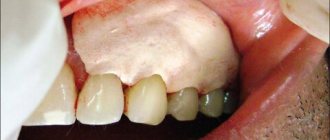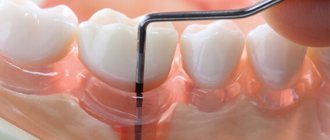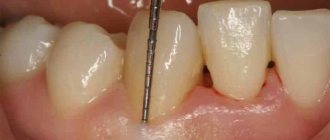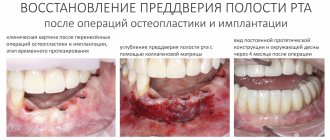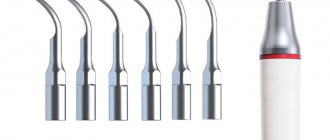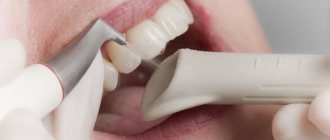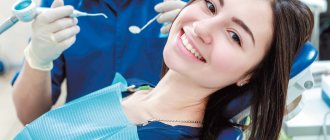Who is recommended for cleaning?
This procedure is recommended for any gum disease. It is usually prescribed when a patient is diagnosed with periodontal disease, periodontitis or gingivitis. Dental manipulation can also be performed if the following symptoms are present:
- Acute reaction to cold or hot.
- Bleeding gums.
- The appearance of “pockets” between the tooth and gum.
- Unpleasant odor from the mouth.
How is the procedure performed?
Periodontal cleaning is performed when the depth of periodontal pockets is increased, if deposits accumulate between the gum tissue and the surface of the tooth enamel and plaque forms. The procedure is similar to closed curettage:
- at the first stage, anesthesia is performed to eliminate pain and discomfort for the patient;
- The space between the gum edge and the enamel is cleaned to its full depth. For this purpose, curettes (mechanical cleaning) or an ultrasonic scaler can be used. Cleaning is carried out in such a way as to completely remove solid deposits;
- The surface of the roots exposed during the procedure is polished;
- Periodontal pockets are treated with antiseptics to their full depth. It is possible to use additional, anti-inflammatory and other local agents.
After curettage is completed, professional teeth cleaning is carried out: removing plaque from their surface, grinding and polishing, fluoridation or coating with protective varnish.
Simultaneous implementation of professional hygiene and periodontal cleaning allows you to clean the entire surface of the enamel, improve the quality of the result, and completely remove soft and hard deposits.
DentoSpas dentists recommend combining professional hygiene and periodontal cleaning in the prevention and treatment of periodontitis, periodontal disease, and gingivitis. The procedure should be performed if you have symptoms:
- the gums become deformed, their color changes (turn red, turn pale), the edge of the gums recedes;
- with bleeding gums (constant or after brushing or eating);
- with bad breath;
- if the tooth roots are gradually exposed, and the depth of the periodontal pockets increases;
- with an unpleasant reaction to sour, cold foods, drinks;
- when tooth mobility occurs.
Do you have questions about periodontal cleanings?
We will call you back within 30 seconds
+7
Execution algorithm
Before you begin cleaning, it is imperative to carry out some diagnostic procedures. Depending on the diagnosis and severity, different procedures may be required:
- Radiography.
- Sanitation of the oral cavity.
- Professional cleaning of units from stone and surface deposits.
The procedure is carried out in two stages, that is, the patient must visit the doctor twice. The algorithm for treating gums through cleaning is individual. Based on your cleaning goals, the steps may vary slightly.
- During the first session, hard formations located in the pockets between the gums and teeth are removed.
- Next, antiseptic treatment is carried out with special medications.
- The dentist applies a therapeutic bandage to the damaged areas of the gums.
- At the second visit, the dentist polishes the teeth and whitens the enamel several shades using an air-abrasive system.
- The final step is to apply fluoride varnish to the surface of the teeth.
After the procedure, a positive effect is observed. Using this procedure, it is possible to remove pathological bacteria, which are often the culprits in the development of oral diseases. After treatment, the likelihood of developing periodontal pathologies is significantly reduced, positive dynamics are clearly observed in existing diseases, and disturbing symptoms disappear.
Periodontal cleaning procedure
A set of medical procedures aimed at hygienic cleaning of teeth in the presence of periodontal pathologies consists of several stages, the first of which is the elimination of deep dental deposits in the subgingival space using special instruments and an ultrasonic scaler. Next, the specialist polishes the root surfaces of the tooth using a special abrasive paste and brushes with silicone attachments, after which medicinal treatment of the affected periodontal canals is carried out.
Brushing your teeth in this case is somewhat different from similar hygienic procedures applied to patients with healthy teeth and gums. When the patient first visits the dental hygienist, hard deposits are removed from the affected periodontal pockets, medicinal treatment of the periodontal pockets is carried out, and a therapeutic bandage is applied to the pathological areas of the dental arch.
During the second visit, the doctor corrects the completed teeth cleaning, polishes and brightens the tooth enamel using an air-abrasive system, and consolidates the result by applying fluoride varnish to the surface of the teeth. The effect of periodontal teeth cleaning is the complete removal of infected bioflora from the affected periodontal pockets, thereby preventing the likelihood of developing periodontal diseases, reducing the risk of the disease becoming absent, and extending the life of teeth.
Features of periodontal cleaning
Since with gingivitis, periodontal disease or periodontitis, the gums are hyperemic and painful, this manipulation can be performed with anesthesia. In this case, the patient will not experience pain or discomfort.
After cleaning, you must follow some rules to secure the result:
- From the moment the procedure is completed, you need to follow a dietary diet so as not to injure the gums and allow them to “heal” calmly. First of all, it is important to observe the temperature regime; food should be warm; cold and hot foods are prohibited during the week. You should also avoid salty, pickled, spicy, etc.
- The duration of the break between two sessions should not exceed seven days.
- Follow your doctor’s recommendations; depending on the diagnosis, the specialist may prescribe certain medications, rinsing the mouth with special solutions, etc.
- If necessary, a specialist may prescribe painkillers.
- Periodontal cleaning is not suitable for everyone; there is a list of contraindications. These include the period of bearing a child, breastfeeding, open foci of infection in the oral cavity.
Indications for periodontal cleaning
Periodontal cleaning (or closed curettage of periodontal pockets) is indicated for gum diseases such as gingivitis, periodontitis, periodontal disease, the main symptoms of which are bleeding gums, the presence of abundant dental plaque, gum recession, and the presence of deep pockets around the teeth. These diseases can lead to exposed roots, bad breath, caries, tooth mobility, and, if the condition worsens, to their loss. To determine the extent of tissue damage, the pocket probing method is used. Normally, the depth of the pockets does not exceed 2-3 mm; the initial stage of periodontitis is characterized by a pocket depth of up to 4-5 mm. At the same time, to normalize the condition of the gums, it is enough to carry out routine professional oral hygiene. When the pocket depth is more than 5-7 mm, we can talk about moderate to severe periodontitis. At this stage of the disease, periodontal cleaning is required.
We recommend regular visits to the dentist and, if initial symptoms of the disease are detected, treatment procedures are carried out, such as: professional oral hygiene, home hygiene procedures, the use of an oral irrigator, and in advanced forms, periodontal cleaning is necessary.
Dental care after oral hygiene
During the day after the procedure, dentists recommend not consuming solid foods, foods and drinks with a coloring effect (berries, chocolate, red wine, coffee, brightly colored vegetables and fruits).
To maintain oral health and prevent accelerated plaque formation, it is necessary to properly care for your teeth:
- brush your teeth morning and evening;
- after each meal or at least once a day, clean the dental spaces with dental floss, and if you have dentures and crowns, use an irrigator;
- supplement care with rinse aid;
- choose a toothbrush of medium and soft hardness so as not to injure the enamel;
- massage the gums if you are predisposed to periodontal disease.
It is equally important to prevent dental diseases and maintain the effect of oral hygiene to ensure a healthy, balanced diet, limit alcohol, tobacco, and coffee.
Indications and contraindications
The procedure is performed for the following symptoms and pathologies:
- bleeding gums, as well as their soreness at rest, while brushing teeth, when biting or pressing;
- unpleasant odor from the mouth;
- mobility of dental units;
- itching, swelling, redness of the gum tissue;
- accumulation of soft pathogenic plaque;
- formation of gum pockets;
- tartar;
- deformation or discoloration of gums;
- exposure of tooth roots;
- periodontitis, periodontal disease, gingivitis.
Contraindications include diseases of internal organs that occur in acute form, viral and infectious pathologies of the respiratory system and ENT organs, severe forms of epilepsy, and diseases of the nervous system.
Result
The therapeutic and prophylactic procedure has a beneficial effect not only on the teeth, but also on the gums. After professional cleaning, foci of infection are completely eliminated, including tartar and pathogenic plaque, the unpleasant odor from the mouth disappears and bleeding gums are eliminated. A correctly performed procedure provides a positive effect for a long time.
Important!
Oral hygiene at home does not give the same results as cleaning in the clinic, therefore, in order to prevent dental pathologies, you should visit a dentist at least twice a year - even if there are no visual signs of disease.
Stages of the procedure
Before prescribing the procedure, the doctor examines the patient’s oral cavity and prescribes an orthopantomogram (panoramic image). Based on the results of the study, the depth of periodontal pockets is determined and a technique is selected in accordance with the individual characteristics of the patient’s body.
If the violation is mild, cleaning is carried out using special devices, after which the base of the dental units is treated with dental curettes - thin sticks with a rounded end.
For deep periodontal pockets, the procedure is carried out according to the following algorithm:
- Introduction of anesthesia.
- Dissection and peeling of the gum flap.
- Cleaning teeth using hand instruments. Curettes and thin hooks are used for these purposes.
- Polishing of teeth.
- Treatment of the oral cavity with antiseptics.
- Applying sutures and gingival dressing.
There may be some pain for a few days after the procedure, but this is completely normal. To ensure that the recovery period passes quickly, the doctor gives recommendations related to the rules of oral care. If you follow the advice of your dentist, then no complications will arise after deep periodontal cleaning.
Stages of periodontal teeth cleaning
- The use of an ultrasonic scaler and a set of specialized instruments makes it possible to remove deep deposits from the subgingival space;
- The next step is to polish the root surface of the teeth with an abrasive paste and a brush with silicone attachments. You should know that these remedies are absolutely harmless and effective;
- Inflamed canals are treated with special medicinal compounds to eliminate the risk of developing the disease in the future;
- Next, using a special product, various types of contaminants and plaque are removed from the oral cavity;
- The final stage is the application of a fluoride-containing gel, which allows you to fix the result.
